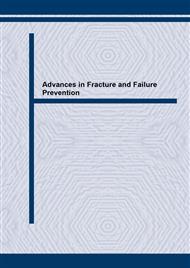[1]
ASTM Standard, E 1820-96. Standard test method for measurement of fracture toughness. Annual Book of ASTM Standards, Section 3, Vol. 03. 01, 1996. pp.981-1013.
Google Scholar
[2]
British Standard BS 7448-1991. Fracture mechanics toughness tests. British Standards Institution, London., (1991).
Google Scholar
[3]
Hellmann D. Schwalbe K-H. Geometry and size effects on J-R and �-R curves under plane stress conditions. In: Fracture Mechanics: 15 th Symposium. ASTM STP 833. Ed. Sanford R J. American Society for Testing and Materials, Philadelphia, 1984, pp.577-605.
Google Scholar
[4]
Hancock J W. Reuter W G. Parks D M. Constraint and toughness parameterised by T. In: Hackett E M, Schwalbe K-H, Dodds R-H, editors. Constraint Effect in Fracture, ASTM STP 1171, American Society for Testing and Materials, Philadelphia, 1993. pp.21-40.
DOI: 10.1520/stp18021s
Google Scholar
[5]
Joyce JA. Hackett EM. Roe C. Effects of crack depth and mode of loading on the J-R curve behaviour of a high-strength steel. In: Hackett E M, Schwalbe K-H, Dodds R-H, editors. Constraint Effect in Fracture, ASTM STP 1171, American Society for Testing and Materials, Philadelphia, 1993. pp.239-263.
DOI: 10.1520/stp18031s
Google Scholar
[6]
Kirk MT. Dodds RH. J and CTOD estimation equations for shallow cracks in single edge notch bend specimens. Journal of Testing and Evaluation. 1993; 21: 228-238.
DOI: 10.1520/jte11948j
Google Scholar
[7]
Wang Y-Y. Gordon J R. The limits of applicability of J and CTOD estimation procedures for shallowcracked SENB specimens. In: Dawes M G, editor. Shallow Crack Fracture Mechanics, Toughness Test and Applications, Cambridge, U.K. (1992).
DOI: 10.1533/9780857093226.3.176
Google Scholar
[8]
Kim Y-J. Schwalbe K-H. On the sensitivity of J estimation to materials’ stress strain curves in fracture toughness testing using the finite element method. Journal of Testing and Evaluation. 2001; 29(1): 18-30.
DOI: 10.1520/jte12387j
Google Scholar
[9]
Nevalainen M. Dodds RH. Numerical investigation of 3-D constraint effects in brittle fracture in SE(B) and C(T) specimens. U.S. Nuclear Regulatory Commission, NUREG/CR-6317, (2001).
DOI: 10.2172/367248
Google Scholar
[10]
Kim YJ. Budden PJ. Plastic � factors of homogeneous and bi-material SE(T) specimens for toughness and creep crack growth testing. Fatigue and Fracture of Engineering Materials and Structures. 2001; 24(11): 751-760.
DOI: 10.1046/j.1460-2695.2001.00436.x
Google Scholar
[11]
ABAQUS Standard/User’s Manual, Version 5. 8. Hibbit. Karlsson & Sorensen, Inc, Pawtucket, RI, USA, (1998).
Google Scholar
[12]
Tada H. Paris P. Irwin G. The stress analysis of cracks handbook. Paris Production Inc., St. Louis, Missouri, (1985).
Google Scholar


